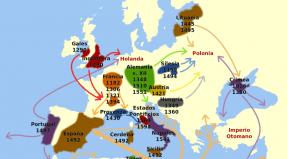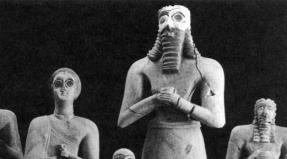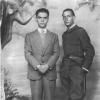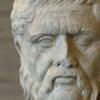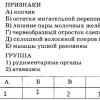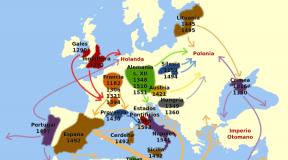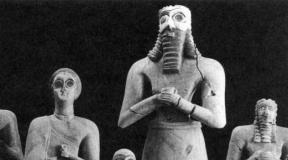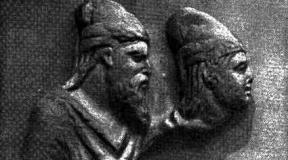Common ancestors of humans and apes. Life of an ancient man. Common ancestors of humans and apes
Level A assignments
Choose one correct answer from the four proposed.
A1. Evidence that a person belongs to the class Mammals is
4) hair growth and viviparity.
A2. A person is assigned to a squad
2) primates.
A3. Human Vestige
1) appendix
A4. Human ancestral home
4) East Africa
A5. Human anatomical feature associated with upright posture
2) springy foot.
A6. Characteristic of human evolution
3) the unity of action of biological and social factors.
A7. The common ancestor of apes and humans is
3) Dryopithecus
A8. Modern man refers to
3) Cro-Magnon.
A9. Among the most ancient people
1) synanthropus.
A10. The biological factor of human evolution is
2) insulation,
3) hereditary variability,
4) natural selection.
A11. The ancestor of man is
4) none of the listed monkeys.
A12. Man is different from all other animals
3) the presence of a second signaling system.
Level B assignments
Choose three correct answers from the six given.
IN 1. Adaptations to an arboreal lifestyle in ancestral primates and modern apes
2) all limbs have five fingers,
4) strong development of the motor parts of the brain,
6) strong development of the shoulder girdle.
AT 2. Distinctive features of humans (compared to apes)
1) chin protuberance on the lower jaw,
2) a foot with a strongly developed big toe, having arches,
4) relatively strong development of the brain skull.
AT 3. Comparative embryology data proving the animal origin of humans
3) two-chamber heart in a two-week embryo,
4) continuous hair on the fetus,
5) development from the zygote.
Match the contents of the first and second columns.
AT 4. Establish a correspondence between the characteristics of a person and the systematic group for which they are characteristic.
AT 5. Establish a correspondence between the characteristics and the group to which they belong. 
AT 6. Establish a correspondence between the factors of human historical development and the group to which they belong. 
AT 7. Establish a correspondence between the characteristics and the races for which they are characteristic. 

Establish the correct sequence of biological processes, phenomena, and practical actions.
AT 8. Establish the sequence of stages of the emergence and evolution of man, starting with the most ancient. 
AT 9. Determine the systematic position of humans as a biological species, arranging taxa in the required sequence, starting with species. 
Scientists have not been able to come to a consensus about who the ancestors of people are; debates in scientific circles have been going on for more than a century. The most popular is the evolutionary theory proposed by the famous Charles Darwin. Taking it as true that man is a “descendant” of the ape, it is interesting to trace the main stages of evolution.
Evolutionary Theory: Human Ancestors
As already mentioned, most scientists are inclined to agree with the evolutionary version that explains the ancestors of people, if you rely on this theory, are apes. The transformation process took over 30 million years, the exact figure has not been established.
The founder of the theory is Charles Darwin, who lived in the 19th century. It is based on factors such as natural selection and hereditary variability.
Parapithecus
Parapithecus is the common ancestor of humans and monkeys. Presumably these animals inhabited the earth 35 million years ago. These are the ones that are currently considered the initial link in the evolution of apes. Dryopithecus, gibbons and orangutans are their “descendants”.
Unfortunately, scientists know little about ancient primates; the data was obtained through paleontological finds. It was found that tree monkeys preferred to settle in trees or open spaces.
Dryopithecus
Dryopithecus is an ancient human ancestor, descended, according to available data, from Parapithecus. The time of appearance of these animals is not precisely established; scientists suggest that this happened approximately 18 million years ago. Semi-terrestrial apes gave rise to gorillas, chimpanzees and australopithecines.

A study of the structure of the animal’s teeth and jaw helped establish that Dryopithecus can be called the ancestor of modern humans. The material for the study was the remains found in France in 1856. It is known that the hands of Dryopithecus allowed them to grab and hold objects, as well as throw them. Apes settled primarily in trees and preferred a herd lifestyle (protection from attacks by predators). Their food consisted mainly of fruits and berries, which is confirmed by the thin layer of enamel on the molars.
Australopithecus
Australopithecus is a highly developed ape-like ancestor of man who inhabited the earth presumably about 5 million years ago. The monkeys used their hind limbs to move and walked in a semi-erect position. The height of the average australopithecus was 130-140 cm; taller or shorter individuals were also found. Body weight also varied - from 20 to 50 kg. It was also possible to establish the volume of the brain, which was approximately 600 cubic centimeters, this figure is higher than that of apes living today.

Obviously, the transition to upright posture led to the release of the hands. Gradually, the predecessors of man began to master primitive tools used to fight enemies and hunt, but they had not yet begun to manufacture them. The tools used were stones, sticks, and animal bones. Australopithecus preferred to live in groups, as this helped to effectively defend against enemies. Food preferences were different; not only fruits and berries were used, but also animal meat.
Outwardly, Australopithecus looked more like apes than humans. Their bodies had thick hair.
A skilled man
Homo habilis was practically no different in appearance from Australopithecus, but was significantly superior to it in development. It is believed that the first representative of the human race appeared approximately two million years ago. The remains were first found in Tanzania in 1959. The brain volume possessed by Homo habilis exceeded that of Australopithecus (the difference was approximately 100 cubic centimeters). The height of the average individual did not exceed 150 cm.

These descendants of Australopithecines earned their name primarily because they began to make primitive tools. The products were mainly stone and were used during hunting. It was possible to establish that meat was constantly present in the diet of Homo habilis. A study of the biological features of the brain allowed scientists to assume the possibility of speech rudiments, but this theory has not received direct confirmation.
Homo erectus
The settlement of this species occurred approximately a million years ago; the remains of Homo erectus were discovered in Asia, Europe, and Africa. The brain volume possessed by representatives of Homo erectus was up to 1100 cubic centimeters. They were already capable of making signal sounds, but these sounds still remained inarticulate.

Homo erectus is known primarily for its success in collective activity, which was facilitated by an increase in brain volume compared to previous stages of evolution. Human ancestors successfully hunted large animals and learned to make fire, as evidenced by piles of charcoal found in caves, as well as charred bones.
Homo erectus had the same height as Homo habilis and was distinguished by the archaic structure of the skull (low frontal bone, sloping chin). Until recently, scientists believed that representatives of this species disappeared about 300 thousand years ago, but recent discoveries refute this theory. It is possible that Homo erectus saw the appearance
Neanderthals
Not so long ago, it was assumed that Neanderthals were the direct ancestors. However, recent evidence suggests that they represent a dead-end evolutionary branch. Representatives of Homo neanderthalensis had a brain whose volume was approximately equal to the volume of the brain endowed with modern people. Outwardly, Neanderthals no longer resembled monkeys; the structure of their lower jaw indicates the ability to articulate speech.

It is believed that Neanderthals appeared about 200 thousand years ago. The places of residence they chose depended on the climate. These could be caves, rocky overhangs, river banks. The tools that Neanderthals made became more advanced. The main source of food remained hunting, which was practiced in large groups.
It was possible to find out that Neanderthals had certain rituals, including those associated with the afterlife. It was among them that the first rudiments of morality arose, expressed in concern for their fellow tribesmen. The first timid steps were taken in such a field as art.
Homo sapiens
The first representatives of Homo sapiens appeared approximately 130 thousand years ago. Some scientists suggest that this happened even earlier. Externally, did they look almost the same? just like the people inhabiting the planet today, the volume of the brain did not differ.

Artifacts found as a result of archaeological excavations make it possible to assert that the first people were highly developed from a cultural point of view. This is evidenced by such finds as cave paintings, various jewelry, sculptures and engravings created by them. It took Homo sapiens approximately 15 thousand years to populate the entire planet. The improvement of tools led to the development of a productive economy; such activities as animal husbandry and agriculture became popular among Homo sapiens. The first large settlements belong to the Neolithic era.
Humans and monkeys: similarities
The similarities between humans and apes are still the subject of research. Monkeys are able to move on their hind limbs, but use their arms as support. The fingers of these animals do not contain claws, but nails. The number of ribs of an orangutan is 13 pairs, while representatives of the human race have 12. The number of incisors, canines and molars in humans and monkeys is the same. It is also impossible not to note the similar structure of organ systems and sensory organs.
The similarities between humans and apes become especially clear when we consider the ways of expressing feelings. They demonstrate sadness, anger, and joy in the same way. They have a developed parental instinct, which manifests itself in caring for the cubs. They not only caress their offspring, but also punish them for disobedience. Monkeys have excellent memory and are able to hold objects and use them as tools.
Humans and monkeys: main differences
Not all scientists agree that great apes are the ancestors of modern humans. on average is 1600 cubic centimeters, while this figure in animals is 600 cubic centimeters. cm. The area of the cerebral cortex also differs by approximately 3.5 times.
The list of differences related to appearance could take a long time. For example, representatives of the human race have a chin and turned out lips, allowing one to see the mucous membrane. They do not have prominent fangs, and their VID centers are more developed. Monkeys have a barrel-shaped chest, while humans have a flat chest. A person is also distinguished by an expanded pelvis and a strengthened sacrum. In animals, the length of the body exceeds the length of the lower limbs.
People have consciousness, they are able to generalize and abstract, use abstract and concrete thinking. Representatives of the human race are capable of creating tools and developing areas such as art and science. They have a linguistic form of communication.
Alternative theories
As already mentioned, not all people agree that monkeys are the ancestors of humans. Darwin's theory has many opponents who present more and more new arguments. There are alternative theories that explain the appearance of Homo sapiens on planet Earth. The oldest theory is creationism, which implies that man is a creation created by a supernatural being. The appearance of the creator depends on religious beliefs. For example, Christians believe that people appeared on the planet thanks to God.
Another popular theory is cosmic. It says that the human race is of extraterrestrial origin. This theory considers the existence of people as the result of an experiment conducted by cosmic intelligence. There is another version that says that the human race originated from alien creatures.
Among the first small mammals - insectivores - in the Mesozoic era a group of animals emerged that did not have sharp teeth and claws, nor wings, nor hooves. They lived both on the ground and in trees, eating fruits and insects. From this group originated the branches that led to prosimians, monkeys and humans.
Parapithecus is considered the oldest great ape, from which the ancestors of humans originated. These ancient, unspecialized apes diverged into two branches: one leading to modern gibbons and orangutans, the other to Dryopithecus, an extinct arboreal ape. Dryopithecus diverged in three directions: one branch led to chimpanzees, another to gorilla, and the third to humans. Humans and apes are closely related. But these are different branches of a common genealogical trunk.
Scientists suggest that the ancestral home of humanity was somewhere in the territory that includes northeastern Africa, South Asia, and southeastern Europe, from where people settled throughout the Earth.
What were the original forms from which the most ancient people originated? To date, such forms have not been discovered, but an idea of them is given by a well-studied group of South African monkeys - Australopithecus (“Australus” - southern). This group lived on Earth at the same time as the earliest people, and therefore cannot be considered the direct ancestors of people.
Australopithecus lived among rocks on flat, treeless spaces, was bipedal, walked slightly bent over, and knew meat; their skull had a volume of approximately 650 cm 3 .
In the early 60s of this century, the English scientist Louis Leakey found fragments of skulls, bones of the hand, foot, lower leg, and collarbone in the Oldovai Gorge on the territory of modern Tanzania (East Africa). The fossil creatures to which they belonged were somewhat closer to humans in the structure of the foot and hand than australopithecines, but their brain volume did not exceed 650 cm 3 . Pointed pebbles and stones that gave the impression of being artificially processed were also found there. According to most Soviet anthropologists, these creatures should also be considered australopithecines. Morphologically they differed little from apes. The difference was in the emergence of the first glimpses of consciousness associated with the use of natural objects as tools, which prepared the transition to their manufacture.
It is believed that the ancestors of the most ancient people were a species of bipedal apes close to the African Australopithecus, which, based on hereditary variability in the process of natural selection, developed the ability to frequently and variedly use sticks and stones as tools.
Common ancestors of humans and apes
Among the first small mammals - insectivores - in the Mesozoic era a group of animals emerged that did not have sharp teeth and claws, nor wings, nor hooves. They lived both on the ground and in trees, eating fruits and insects. From this group originated the branches that led to prosimians, monkeys and humans.
Parapithecus is considered the oldest great ape, from which the ancestors of humans originated. These ancient, unspecialized apes diverged into two branches: one leading to modern gibbons and orangutans, the other to Dryopithecus, an extinct arboreal ape. Dryopithecus diverged in three directions: one branch led to chimpanzees, another to gorilla and the third to humans. Humans and apes are closely related. But these are different branches of a common genealogical trunk.
Scientists suggest that the ancestral home of humanity was somewhere in the territory that includes northeastern Africa, South Asia, and southeastern Europe, from where people settled throughout the Earth.
What were the original forms from which the most ancient people originated? To date, such forms have not been discovered, but an idea of them is given by a well-studied group of South African monkeys - Australopithecus (“Australus” - southern). This group lived on Earth at the same time as the earliest people, and therefore cannot be considered the direct ancestors of people.
Australopithecus lived among rocks on flat, treeless spaces, was bipedal, walked slightly bent over, and knew meat; their skull had a volume of approximately 650 cm 3.
In the early 60s of this century, the English scientist Louis Leakey found fragments of skulls, bones of the hand, foot, lower leg, and collarbone in the Oldovai Gorge on the territory of modern Tanzania (East Africa). The fossil creatures to which they belonged were somewhat closer to humans in the structure of the foot and hand than australopithecines, but their brain volume did not exceed 650 cm 3 . Pointed pebbles and stones that gave the impression of being artificially processed were also found there. According to most Soviet anthropologists, these creatures should also be considered australopithecines. Morphologically they differed little from apes. The difference was in the emergence of the first glimpses of consciousness associated with the use of natural objects as tools, which prepared the transition to their manufacture.
It is believed that the ancestors of the most ancient people were a species of bipedal apes close to the African Australopithecus, which, based on hereditary variability in the process of natural selection, developed the ability to frequently and variedly use sticks and stones as tools.
In the process of human development, three stages or phases should be distinguished: 1) the earliest people, 2) the ancient people and 3) the first modern people.
The earliest people
The transition from fossil apes to humans took place through a series of intermediate creatures that combined the features of apes and humans - ape people. It is believed that they appeared at the beginning of the Anthropocene, i.e. about a million years ago.
Pithecanthropus means "monkey man". His remains were first discovered by the Dutch doctor Dubois in 1891 on the island. Java. Pithecanthropus walked on two legs, leaning slightly forward and possibly leaning on a club. He was about 170 tall cm, his skull was the same length and width as that of a modern person, but lower and consisted of thick bones. Brain volume reached 900 cm 3: The forehead is very sloping, there is a continuous ridge of bone above the eyes. The jaws protruded strongly forward, there was no chin protrusion.
Pithecanthropus created the first tools from stone, which were found in the same layers as bones. These are primitive scrapers and drills. There is no doubt that Pithecanthropus used sticks and branches as tools. The most ancient people thought, invented,
The emergence of labor turned out to be a powerful impetus for the development of the brain. Darwin attached exceptional importance to the high mental development of our ancestors, even the most ancient ones. The development of the mind took a big step forward with the emergence of speech. According to F. Engels, the rudiments of speech arose among the most ancient people in the form of inarticulate sounds that had the meaning of various signals.
Interesting finds Sinanthropa- “Chinese man”, who lived somewhat later than Pithecanthropus. His remains were found in 1927-1937. near Beijing.
Externally, Sinanthropus resembled Pithecanthropus in many ways: a low forehead with a developed brow ridge, a massive lower jaw, large teeth, and no chin protrusion.
However, Sinanthropus were more advanced creatures. Their brain volume ranged from 850 to 1220 cm 3; The left lobe of the brain, where the motor centers of the right side of the body are located, was slightly larger compared to the right lobe. Consequently, the right hand of Sinanthropus was more developed than the left. Sinanthropus mined and knew how to maintain fire, and apparently dressed in skins. The excavations revealed a thick layer of ash, charred branches, tubular bones and skulls of large animals, tools made of stones, bones, and horns.
In 1907, near the city of Heidelberg in Germany (in the modern territory of the Federal Republic of Germany), a very massive lower jaw was found, without a chin protrusion, but with teeth, like a person’s. The owner of this jaw was named Heidelberg person. Pithecanthropus and Sinanthropus are considered two species of the first subgenus - ape-men (genus of people): Pithecanthropus erectus and Peking Sinanthropus. They are representatives of the first initial stage of the transformation of ape into man; according to F. Engels, these are “formed” people. From them came representatives of the second stage of humanization - the Neanderthals. Some researchers classify Heidelberg Man as one of the most ancient people, and others as one of the ancients.
Ancient people
Entire skeletons of adults and children were discovered in the lowest layers of cave deposits in Europe, Asia and Africa. Neanderthals(named after the place of discovery in 1856 - the Neander River valley in Germany on the modern territory of the Federal Republic of Germany). In the USSR, the remains of Neanderthals were discovered in the south of Uzbekistan and Crimea. The first settlements of Neanderthals date back to 400-550 thousand years ago.
Neanderthals were shorter than us, stocky (men on average 155-158 cm), They walked slightly bent over. They also had a low, sloping forehead; strongly developed superciliary arches hung at its base, the lower jaw without a mental protuberance or with its weak development. The volume of the brain was approaching the human brain - about 1400 cm 3, but there were fewer brain convolutions. Their spinal curvature in the lumbar region was less than that of modern humans. They lived in difficult conditions of the advance of glaciers, in caves where they constantly maintained a fire. They ate plant and meat foods. Neanderthals owned stone and bone tools. Apparently they also had wooden tools.
Judging by the structure of the skull and facial bones, scientists believe that when communicating with each other, Neanderthals used gestures, inarticulate sounds and rudimentary articulate speech. They lived in groups of 50-100 people together. The men hunted animals; women and children collected edible roots and fruits; the older, more experienced ones made the tools. Neanderthals dressed in skins and used fire. Neanderthals are considered a species belonging to the second subgenus - ancient humans (genus of humans). They are the ancestors of the first modern people - the Cro-Magnons.
First modern humans
There are a large number of finds of skeletons, skulls and tools of the first modern people - Cro-Magnons(the name of the town of Cro-Magnon in the south of France), who lived 100-150 thousand years ago. The remains of Cro-Magnons were also discovered in Russia (south of Voronezh, on the right bank of the Don). Cro-Magnons were up to 180 tall cm, with a high straight forehead and cranial volume up to 1600 cm 3; there was no continuous supraorbital ridge. A developed chin protrusion indicated good development of articulate speech. Cro-Magnons lived in dugouts and caves with painted walls. Tools made of horn, bone, and flint are very diverse and decorated with carvings. Episodes of hunting, sacred dances, people and deities were depicted on the walls of dwellings. The drawings are made with ocher and other mineral paints or scratched. Cro-Magnons dressed in clothes made of skins, sewn with bone and flint needles. The technology for making tools and household items is much more advanced than that of the Neanderthals. The man knew how to grind, drill, and knew pottery. He tamed animals and took his first steps in agriculture. The Cro-Magnons lived in a tribal society.
Cro-Magnons and modern humans form the species Homo sapiens - reasonable person belonging to the third subgenus - new people (genus of people).
Thus, having risen from the animal world, our ancestors, as a result of a complex and long process of human formation, turned into people of the modern species. Social factors and laws became leading and determining. This is the qualitative uniqueness of human evolution compared to the evolution of animals.
Hereditary variability and natural selection still take place among people, but on the basis of developing knowledge and social reorganization, a person learns to control biological laws, prevent harmful manifestations and enhance beneficial ones.
Read also...
- Plato - biography and philosophical teachings What Plato believed
- Common ancestors of humans and apes
- Electronic formula nb. Electronic formulas. Distribution of electrons using the periodic system of D. I. Mendeleev
- Endangered languages. What is a dead language? List of dead languages. Should we start sounding the alarm?

